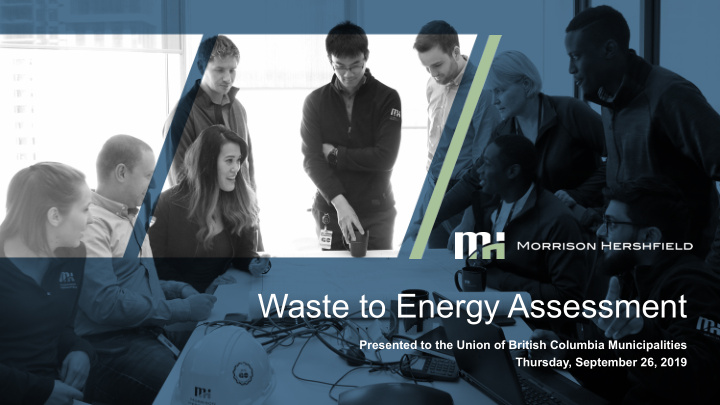



Waste to Energy Assessment Presented to the Union of British Columbia Municipalities Thursday, September 26, 2019
Presentation Overview 1. WTE Overview 2. Intro to Comox Strathcona Waste Services (CSWM) 3. WTE Study Results 4. Questions
What is WTE? § Technologies offer different ways of releasing the energy in the waste § Conventional WTE systems § Essentially power plants using waste as fuel instead of natural gas, coal or wood § Advanced WTE systems § Use heat to convert the energy in the waste into a gas that can be burned for power, or converted to fuel (for burning)
Where does WTE fit in? Reduce § 4 th R - Recovery of energy Reuse and materials after the first 3Rs, prior to disposal Recycle Recovery Residuals 4
The role of WTE in an Integrated System § With recycling and organics treatment: Recycling Organic Treatment Thermal Treatment Landfill Landfill
Metro Vancouver WTE Facility § Operational since 1988 § 250,000 tonnes per year § Numerous upgrades § Meets all air emission standards
York Durham WTE § Newest WTE plant in Canada. Started operations 2016 § Mass burn technology § Capacity 140,000 tonnes per year, upgrading to 160,000 § Ultimate capacity 400,000 tonnes per year
Intro to CSWM
WTE Study Results § Study objectives – update 2011 study of overall system costs and greenhouse gas emissions § Assess current technologies and market § Three potential locations reviewed § Estimated system costs: § Transfer station construction and operation § Landfill operation, closure and post closure § WTE facility construction and operation § Estimated GHG emissions for each system § RFI – two vendors shortlisted
Average Disposal Cost per Tonne Increasing capacity - Estimated average disposal cost per tonne Option Over 40 years 0 Status Quo $75 1(a) WTT in Comox Valley $163 3(a) Sustane in Comox Valley $107
Total Disposal Costs
System Cost Breakdown
THANK YOU Todd Baker, P. Eng. 778-874-4299
Recommend
More recommend